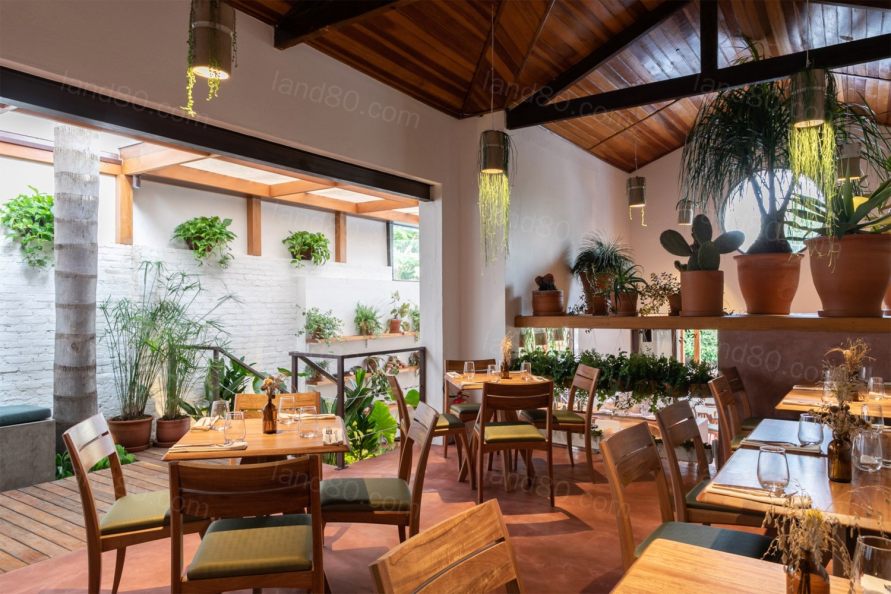"一家素食餐厅,重视巴西不同地区的小生产者提供的有机和天然食材,位于一个自然采光充足的空间里,人人都可以进入,对宠物也很友好。" 这些都是促使位于巴西圣保罗的Cajuí餐厅成立的主要基础。随着对前期建筑的初步评估,客户理想化的概念是制定第一份建筑草案的主要依据。场地入口处的大面积积水,现有建筑的众多层次,以及由于狭窄的地块而造成的黑暗,几乎完全被覆盖,这些都是设计的极大挑战。
"A vegan restaurant, that values organic and natural ingredients supplied by small producers from different regions of Brazil, located in a space with plenty of natural lighting, accessible to everyone and pet friendly." These are the major foundations that motivated the establishment of Cajuí Restaurant, located in São Paulo, Brazil. Along with the initial assessment of the pre-existing construction, the concept idealized by the client was the main basis for the development of the first architectural drafts. The big acclivity right at the access to the site, the numerous levels of the existing construction and the darkness due to the narrow plot, practically entirely covered, indicated the physical challenges for the implementation of the architectural concept.


最初,为了满足后勤和功能性的需求,空间被一个小体量划分为两个区域,包括残疾人的浴室和酒吧。在平面的布置上,原有的楼梯被替换,以减少原有平台的数量来克服倾斜,提供更流畅和简单的流线。此外,为了让每个人都能进入餐厅,有必要设置一个从人行道水平到酒吧水平的升降平台,以确保能进入较低的休息室、卫生间和酒吧。
Initially, with the intention to attend the logistical and functional premises, the space was divided in two zones by a small volume, containing the bathroom for the disabled and the bar. Strategically located, the stairs were replaced in order to reduce the number of pre-existing plateaus to overcome the inclination, providing a more fluid and intuitive circulation. Additionally, to make the restaurant accessible to everyone, it became necessary to set a lifting platform from the sidewalk level to the bar level in order to guarantee accessibility to the lower lounge, toilet and bar.


餐厅的名字直接参考了一种名叫Cajuí的小水果,这种水果来自巴西塞拉多,可以作为一种腰果。这个名字是为了提醒人们注意这个丰富而独特的生物群落的森林日益被砍伐,这也是餐厅菜单和氛围的灵感来源。这样一来,在设计过程中,光与色之间的互动价值被作为一个极其重要的事项,以光、色和材料营造出一种氛围,在美学上暗合巴西Cerrado的风格。在整个创作过程中,自然与建筑之间的这种关系受到了格外的关照,每一个设计决定都考虑到了这一点。
Resuming the subjective aspects aspired by the design, the name of the restaurant is a direct reference to the small fruit Cajuí, a native fruit of the Brazilian Cerrado that belongs to the cashew family. The name comes as an alert for the growing deforestation of this rich and unique biome, which serves as an inspiration for both the menu and the ambience of the restaurant. In this manner, the value of the interaction between light and color was adopted as an extremely important matter during the design process, in a way that light, colors and materials create an ambiance that aesthetically alludes to the Brazilian Cerrado. This relationship between nature and architecture was exceptionally cared for throughout the creation process and it was considered in every design decision.




翻修前的建筑元素是由砖石结构组成,周围是不稳定的临时结构。由于其中一个前提是避免对建筑进行重大的结构翻新,因此采用的解决方案是将主要的干预措施集中在这些临时结构上,制作一个新的围护结构,以实现庇护的功能,同时,负责自然光的传输和室内外空间的互动。
The architectural elements identified in the building before the renovation consisted in a masonry construction surrounded by precarious temporary structures. As one of the premises was to avoid major structural refurbishments in the building, the adopted solution was to concentrate the main interventions on these temporary structures, making a new envelope that fulfills the function of shelter and, at the same time, is responsible for the transmission of natural light and interaction between interior and exterior spaces.


得到的结果是在现有建筑的主体上附加了一个木质结构。半透明的屋顶瓦片允许自然光进入,通过有机黄麻衬里的过滤,在一天中的不同时段影响内部环境的颜色。以Cerrado土壤为参考,带有红色颜料的水泥地面与光线起到了和谐的作用,使白色的墙面吸收了项目中使用的一些土色,有助于传递所需的气氛。
The obtained result was a wooden structure attached to the body of the existing building. The translucent roof tiles allowed the entry of natural light that, filtered through the organic jute lining, influences the color of the internal environment during the different hours of the day. Used as a reference to the Cerrado soil, the cement floor with red pigmentation acts in harmony with light, making the white walls absorb some of the earthy colors used in the project, helping to transmit the desired atmosphere.

除了在装修过程中尽量减少干扰外,还保证了施工现场产生的几乎所有废弃物都得到了再利用,无论是等待区平台、平整地面还是小区后区的竹制天花板。在员工区旁边,建有大面积的花坛,用来种植菜单中的主要食材。在所有环境中展示的景观,超越了装饰性,成为功能性,在餐厅的建筑中发挥着重要作用。
Along with the attempt to minimize interferences during the renovation, it was ensured that almost all the waste generated on the construction site was reused, whether for the waiting area deck, for leveling the floors or for the bamboo ceiling in the back area of the plot. Next to the staff area, large plant beds were built to grow the main ingredients used in the menu. The landscaping displayed in all environments, goes beyond the decorative and becomes functional, playing an important role at the restaurant's architecture.

▼项目图纸 Drawings






项目名称:Cajuí Restaurant
设计单位:VAGA
网站:www.vaga.arq.br
项目地点:巴西 圣保罗
竣工年份:2020
首席建筑师:Fernando O’Leary, Pedro Domingues, Pedro Faria
建筑团队:CauêMartins,Gabriela Inomata,Tali Liberman
景观设计:Planta Plena
图片来源:Pedro Napolitano Prata
Project name: Cajuí Restaurant
Company name: VAGA
Website: www.vaga.arq.br
Project location: São Paulo, Brazil
Completion Year: 2020
Lead Architects: Fernando O’Leary, Pedro Domingues, Pedro Faria
Architecture Team: Cauê Martins, Gabriela Inomata, Tali Liberman
Landscape: Planta Plena
Photo credits: Pedro Napolitano Prata
|